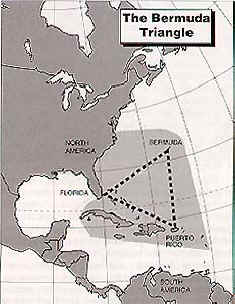Bermuda triangle - whats going on there?

Countless theories attempting to explain the many disappearances have been offered throughout the history of the area. The most practical seem to be environmental and those citing human error. The majority of disappearances can be attributed to the area's unique environmental features.
It has been said that the "Devil's Triangle" is one of the two places on earth that a magnetic compass does point towards true north. Normally it points toward magnetic north. The difference between the two is known as compass variation. The amount of variation changes by as much as 20 degrees as one circumnavigates the earth. If this is the case and a compass variation or error is not compensated for, a navigator could find himself far off course and in deep trouble.
Another environmental factor is the character of the Gulf Stream. It is extremely swift and turbulent and can quickly erase any evidence of a disaster. The unpredictable Caribbean-Atlantic weather pattern also plays its role. Sudden local thunder storms and water spouts often spell disaster for pilots and mariners. Finally, the topography of the ocean floor varies from extensive shoals around the islands to some of the deepest marine trenches in the world. With the interaction of the strong currents over the many reefs the topography is in a state of constant flux and development of new navigational hazards is swift. Not to be under estimated is the human error factor. A large number of pleasure boats travel the waters between Florida's Gold Coast and the Bahamas. All too often, crossings are attempted with too small a boat, insufficient knowledge of the area's hazards, and a lack of good seamanship.
Dissapeareances from 1976 onwards:
1976, October 13/15
SYLVIA L. OSSA - A 590 foot ore carrier disappeared approximately 140 miles west of Bermuda with a crew of 37
"The Changing Seaway" - Alfred F. Sagon-King & Skip Gillham
Originally named MARATHONIAN the SYLVIA L. OSSA operated under Panamanian registry and disappeared in heavy
seas west of Bermuda between October 13th and 15th. -
1991, August 28
AMERICAN AIRLINES INC AIRBUS - Makes emergency landing due to turbulence
Reuters
Hamilton, Bermuda, Aug 28 -- An American Airlines Inc Airbus made an emergency landing in Bermuda today after an
air pocket sent the aircraft plunging 1,000 feet, injuring about 30 people, passengers said. About 170 people were on
board Flight 1473 from New York (John F. Kennedy) International Airport to San Juan (Luis Munoz Morin) International
Airport, Puerto Rico, when it hit severe turbulence over the Atlantic. About 30 were treated at Bermuda hospitals for injuries,
including bruises and broken bones. The most serious cases involved three patients who suffered heart problems. One of
them was still in intensive care in hospital about six hours later, hospital spokesmen said. The aircraft's captain radioed to
Bermuda to alert ground crews for an emergency landing after the aircraft finally righted itself, airport officials said. -- .
1993, March 13
CHARLEY'S CRAB, CHARLES MUER - Restaurateur Charles Muer, his wife Betty and friends
George and Lynn Drummey disappear between the Bahamas and Florida on the Muer's 40 foot
ketch Charley's Crab in 30 foot seas with 70 mph winds in what is later referred to as
"the storm of the century". No trace of victims or wreckage was recovered.
http://www.sptimes.com/StormWatch/SW.3.1.html http://www.landrysseafood.com/financial/releases/press_021902.htm
1994, November 28
AMERICAN AIRLINES INC AIRBUS A300 - Battered by clear air turbulence over Martinique
Reuters
San Juan, PR, Nov 28 -- More than 40 people were injured, six seriously, when their American Airlines Inc Airbus A300 ran
into unexpected turbulence over the Caribbean today. A spokesman for the Dallas-based airline said 212 passengers and
nine crew members were on board Flight 1218 at about 1830, EST (2330, UTC), when the aircraft left Bridgetown Airport,
Barbados, for San Juan International Airport on the first leg of a trip to Boston. The aircraft encountered a pocket of clear air
turbulence, or turbulence not caused by a storm, above the island of Martinique, about 370 miles south-east of San Juan,
and dropped abruptly shortly after reaching its cruising altitude of 35,000 feet. "I gather some of the passengers and flight
attendants were thrown around the cabin," said airline spokesman Don Bedwell. Forty-six people were taken to three San
Juan hospitals for observation, treatment of head wounds and other injuries including coffee burns. The spokesman said
about six people sustained serious, but not life-threatening, injuries. -- .
1995, March 20/24
JAMANIC K - A motor vessel (mv) of 357 gross tons, lost in route from Cape Haitian to Miami
Lloyd's Agents / Lloyd's Casualty List
London, Mar 24 -- Following received from Coast Guard Miami, timed 1451, UTC: Mv Jamanic K. (357 gt, built 1943)
overdue Cap Haitian to Miami since Mar 20. Honduran registry. --
1995, June 25
CONTINENTAL AIRLINES INC FLIGHT 207 - Flight encounters clear air turbulence
United Press International
San Juan, June 25 -- Twenty-two passengers on a flight to Puerto Rico were injured today when air turbulence caused violent
movements on the aircraft in which they were travelling. Continental Airlines Inc Flight 207, which was carrying 257 passengers
from Newark, New Jersey, to San Juan, experienced the turbulence at about the mid-point of the flight. Authorities in the Puerto
Rican capital were advised, and emergency medical workers were waiting at the San Juan airport on the aircraft's arrival to help
treat the injured. Herman Sulsona, the head of the Puerto Rico Port Authority, said the problem was caused by "clear air turbulence,
a phenomenon of turbulence which can't be predicted because it doesn't show up on the radars." Sulsona said most of the 22
people injured, mainly young adults and children, suffered only minor bruises, but that four had neck injuries. Most were brought to
San Juan hospitals. Jose Rodriguez, a passenger on the flight, said in reports in San Juan that when the aircraft experienced the
turbulence, it dropped suddenly and then suddenly rose up again, causing passengers to fly from their seats.
-- .
1996, October, 14
INTREPID - A 65 foot yacht missing thirty miles off Fort Pierce, Florida after issuing a quick MAYDAY.
Reuters
Miami, Oct 14 -- Sixteen people were missing after reporting last night that they were abandoning their sinking yacht
off Fort Pierce, Florida, the Coast Guard said today. The Coast Guard said yacht Intrepid, 65-foot length, sent out
a distress call saying she was sinking and everyone on board was escaping on a life raft. The Coast Guard said four
aircraft searched all night for the life raft and today two aircraft and a cutter were still looking for her, about 30 miles off
Fort Pierce, on Florida's east coast north of Palm Beach. The Coast Guard said seas in the area were rough with waves
up to seven feet high. -- .
Reuters
Miami, Oct 14 -- The US Coast Guard gave up the search today for 16 people who went missing after reporting last night
they were abandoning sinking yacht Intrepid off Fort Pierce, Florida, a Coast Guard spokesman said. The Coast Guard
said the crew of Intrepid, sent out a distress call saying she was sinking and everyone on board was escaping on a life raft.
They had no information of the yacht's home port or nationality of the crew. Coast Guard Lt. Robert Engle said the search
was suspended late this afternoon, after crews had searched 6,000 sq. miles of water about 30 miles off Fort Pierce, on
Florida's east coast north of Palm Beach. -- .
1996, January 17
AMERICAN AIRLINES INC AIRBUS A300 - Hit by heavy turbulence over the Bahamas
United Press International
San Juan, PR, Jan 17 -- Twenty-six passengers were injured today when an American Airlines Inc Airbus A300 hit heavy
turbulence over the Bahamas on a flight from Miami to Puerto Rico, officials said. Flight 869 was 100 miles east of Nassau,
in the Bahamas, when it struck the severe turbulence at 33,000 feet, aviation authorities said. American Airlines spokesman
Gus Whitcom said three of the injured were badly hurt, and were rushed to hospitals after the plane landed at Puerto Rico's
Luis Munoz Marin International Airport this afternoon. Two were placed on stretchers, with neck braces, and transported by
helicopter to the Ashford Hospital in the Condado tourist zone. A 10-month-old baby was also taken to the hospital with a
suspected broken collarbone. Twelve others were taken to hospitals for checks, while 11 suffered only minor injuries. All
received treatment on board the aircraft, which was carrying 268 passengers and nine crew members. Witnesses said most
of the injuries in the head, neck and back areas. The mother of the baby, who identified herself only as Mrs. Maxwell, said "I
had him on my lap, and suddenly, the turbulence tossed him into the air inside the cabin." -- .
1999, April 15
MISS FERNANDINA - An 85 foot shrimp trawler lost off Flagler Beach, Florida
Lloyd's Agents / Lloyd's Casualty List
London, Apr 23 -- A Press report, dated Port Canaveral Apr 22, states: A U.S. Coast Guard search for missing
85-ft shrimp trawler Miss Fernandina, and her four-member crew was called off last night after six days of
round-the-clock air and water searches. Miss Fernandina left Port Canaveral early Thursday (Apr 15) morning. That night,
the vessel's owner and master called a fellow shrimper to request assistance because his nets had become tangled in his
propeller. The master, Kenny Jones, 39, of Fernandina Beach, said the vessel was also experiencing electrical difficulty
and listing slightly. When the other vessel arrived at the reported location of Miss Fernandina, 65 miles east of Flagler
Beach, there was no sign of the shrimper or her crew. Seas were running 6 to 8 feet and winds were 25 miles per hour
in the area, the Coast Guard reported. The Coast Guard launched its search next morning. During the 136 hours of
searching, three Coast Guard vessels, one jet, 10 other planes and four helicopters were used to scour a 75,000-square
mile area. The search was called off yesterday at nightfall with Mayport commander Lt. Cmdr. James Rendon saying
they had "exhausted all efforts." A Coast Guard plane spotted what was thought to be debris from the vessel Tuesday.
Two people were also seen in the water, floating face down. Neither made any response to the plane's repeated efforts
to rouse them. The plane, low on fuel, used a marker to help identify the spot, refueled and returned to the search with
additional vessels and aircraft. The marker was located, but the bodies have not been seen again.
1999, April 23
GENESIS - A motor vessel (mv) of 196 gross tons that disappeared in route from Port of Spain, Trinidad to St. Vincent
Lloyd's Agents / Lloyd's Casualty List
Port of Spain, May 12 -- A local press report, dated today, states: M research vessel Genesis (196 gt, built 1967),
Trinidad for St. Vincent with 465 tons of cargo, including concrete slabs, bricks and water tanks, has disappeared
without a trace. The vessel, with three crew, is believed to have sunk about 21 miles off the coast of St. Vincent.
The vessel sailed Port of Spain Apr 23. Coast Guard sources said the Genesis radioed a nearby vessel, MV Survivor,
around 1730 hrs, saying their bilge pump had pulled in a rag and that they were switching to the gas pump to rectify
the situation. The vessel has not been heard from or seen since. After days of searches by the Coast Guard covering
33,100 square miles both in and out of local waters, the men are now feared dead. International Freight Consolidators
Ltd at Independence Square, Port of Spain, are the agents for the vessel. --
1999, June 14
CESSNA 210 - Drops off radar from Freeport to Nassau
Lloyd's Agents / Lloyd's Casualty List
London, Jun 14 -- Following received from Coast Guard Miami, dated Jun 11: The crew of a Coast Guard HH-60 Jayhawk
helicopter is searching for two people after their single-engine airplane disappeared from the radar screen, about three
miles north of Great Harbor Cay, Bahamas. The Nassau Air Traffic Control Tower notified the Coast Guard Command
Center in Miami at 1447, today, that a Cessna 210 was missing. The aircraft was en route to Freeport, Bahamas from Nassau.
The aircraft reportedly had six lifejackets on board. --
1999, July 8
CONTINENTAL AIRLINES BOEING 737-800 - Forced to make emergency landing in Bermuda due to turbulence
Reuters
Hamilton, Bermuda, Jul 8 -- Dozens of people on a Continental Airlines flight suffered minor injuries when their
Boeing 737-800 ran into severe turbulence over the Atlantic and was forced to make an emergency landing in
Bermuda today, officials said. Continental Flight 743, en route to San Juan, Puerto Rico, from Newark, New
Jersey, with 159 people on board, was flying about 180 miles southeast of Bermuda at about 29,000 feet when
it hit the turbulence, an airline spokeswoman said. Fifty-nine passengers and all four flight attendants on board
were taken to Bermuda's King Edward VII Memorial Hospital for treatment of minor injuries, and four were being
held for observation, a hospital spokeswoman said. "The majority of them are complaining of neck pain and neck
injuries, and there are bruises and scrapes," hospital spokeswoman Sheila Manderson said. The plane left Newark
at 1220, EDT, with 153 passengers and six crew members aboard. It made its emergency landing at Bermuda
International Airport at about 1604, Atlantic time, she said. Passengers who were not injured were being taken to
local hotels and would continue their trip to Puerto Rico tomorrow Continental spokeswoman Karla Villalone said.
"Obviously, we're checking out the plane as a precaution, and we'll bring in a new plane overnight to take the
passengers on to San Juan," she said. -- .
2001, March 26
COMAIR FLIGHT 5054 - Ice damage on the flight from Nassau to Orlando, FloridaReuters
Washington, Mar 26 -- A Comair aircraft with 25 passengers on board rolled from side and side and dived steeply last week
after the crew reported a build-up of ice on the aircraft, safety investigators said today. The aircraft landed safely in West Palm
Beach, Florida, and no one was injured, but key tail components of the Brazilian-made Embraer-120 propeller-driven aircraft
sustained serious damage, the National Transportation Safety Board said in a report on the Mar 19 incident. Comair Flight
5054 from Nassau, Bahamas, to Orlando, Florida, was at 18,000 feet when ice covered the aircraft's windshield. When the
windshield was clear, the crew noticed a build-up of ice on components of the right engine and wing, the safety board said in
its report. The crew turned on the aircraft's anti-icing systems to their highest settings. The aircraft, which had been travelling
at 200 knots, began to lose speed, which could not be increased with more power and corrective maneuvers. The flight data
recorder showed that while travelling around 130 knots the aircraft rolled to the left and almost back to level. The aircraft then
rolled to the left again before almost leveling off and then to the right before coming back to near level once more. The EMB-120
then rolled sharply to its right and began a steep descent. According to the crew, a key flight instrument that delivers information
about the vertical position of the nose was not working properly during the roll and dive. At 10,000 feet, the aircraft leveled off
and was diverted to West Palm Beach. It landed without incident about 12 minutes after the rolling began. The crew reported
the aircraft's systems, including its ice detection and anti-ice systems, functioned normally before the incident. -- .



